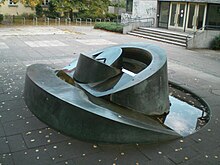Ursula Sax
Ursula Sax (born July 27, 1935 in Backnang ) is a German visual artist and sculptor .
Life
Between 1950 and 1955, Sax studied sculpture at the State Academy of Fine Arts in Stuttgart . From 1956 to 1960 she continued her studies at the Hochschule der Künste in Berlin , where she became a master student of Hans Uhlmann .
From 1960, Sax worked freelance in Berlin, in that year already endowed with a travel grant from the Berlin Cultural Senate for Greece and a grant from the cultural group in the Federal Association of German Industry .
In 1985/1986 and 1989 she received a visiting professorship at the Berlin University of the Arts. From 1990 she was appointed professor at the Braunschweig University of Fine Arts , which was followed by a professorship at the Dresden University of Fine Arts in 1993 .
With his retirement in 2000, Sax began to work freelance again. Ursula Sax lived and worked in Radebeul before returning to Berlin at the beginning of 2013. Between 1966 and 1996, Ursula Sax took part in a total of twelve annual DKB exhibitions as a member of the German Association of Artists .
Her sister Uta became an actress .
Act
Ursula Sax's work is multi-faceted and divided into different sections, in which she turned to a specific material over several years.
In an early phase, from 1954 to around 1962, it was sculptures made from logs, core sculptures organized around an axis. From 1957 to 1960 she worked with iron, from 1970 to 1980 she made sculptures and interior constructions made of wood, such as beams and boards. From 1991–1996 Ursula Sax realized wind sculptures and flags made of fabric as well as wind and air dresses, which were shown in motion in the context of performances in public places and on theater stages.
From the beginning of her artistic activity she was interested in the conditions of sculpture and its handling of sculptural-spatial issues as well as an explicit relationship to architectural spaces. This resulted in numerous sculptures in public spaces such as the large sculpture Looping at the Berlin exhibition center . Parallel to the spatial, three-dimensional works made of heavy materials, there are work groups with works on and made of paper.
If Ursula Sax was initially more about form and space, about the abstract and the constructive, her latest work, for example the crucifixes made of wrapping paper and graphics with numbers, is about time and transience.
Awards
- 1960: Travel grant for Greece, Berlin Senate for Culture
- 1960: Scholarship from the Kulturkreis der deutschen Wirtschaft in the BDI
- 1963: Villa Romana Prize
- 1974: Will Grohmann Prize
- 1976: Villa Massimo grant
- 1977: Bremen Art Prize
- 1979: Cité internationale des arts Paris
- 1980: Hand-Hollow, USA
- 1998: Guest of Honor at Villa Massimo, Rome
- 2017: Art Prize of the State Capital Dresden
plant
- Numerous solo and group exhibitions
- Work in private and public ownership
- Architecture-related work in public space
- "Rotations" ZDF broadcasting center Mainz, 1975.
- Performance on stages and in the outside space with wind objects, wind and air clothes
literature
- Patrick-Daniel Baer: Werk Sax: Catalog raisonné by the sculptor Ursula Sax . Verlag der Kunst, Dresden 2002, ISBN 978-3-364-00428-0 .
- Marc Fredric Gundel: Academy student body and teaching after 1945. On the importance and problems using the example of Otto Baum and Herbert Baumann as art college teachers , dissertation University of Heidelberg, Heidelberg 1995, pages 62–64.
Web links
- Literature by and about Ursula Sax in the catalog of the German National Library
- Artist's website
- Ursula Sax at kunstknall.de
- Ursula Sax at artfacts.net
Individual evidence
- ↑ vorschau-rueckblick.de: On the 80th birthday of Prof. Ursula Sax (accessed on January 8, 2016)
- ↑ Karin Gerhardt: Interest in the Radebeul art collection is growing. In: Preview & Review; Monthly magazine for Radebeul and the surrounding area. Radebeuler Monatshefte eV, January 2013, accessed on January 1, 2013 .
- ↑ kuenstlerbund.de: Exhibition participation / Sax, Ursula (accessed on January 8, 2016)
| personal data | |
|---|---|
| SURNAME | Sax, Ursula |
| BRIEF DESCRIPTION | German artist |
| DATE OF BIRTH | July 27, 1935 |
| PLACE OF BIRTH | Backnang |


